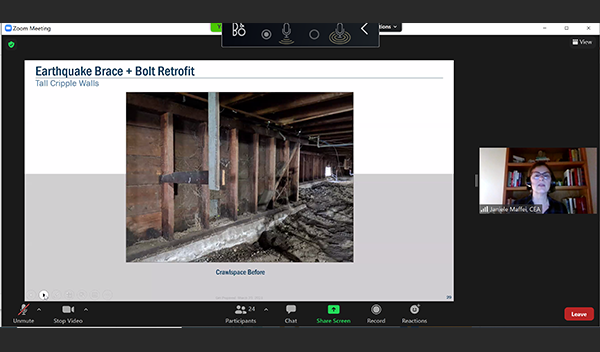Already six months into 2021, as California starts reopening after the COVID-19 pandemic, CEA continues moving forward with its community outreach efforts. We have been actively meeting with diverse groups, from Northern California to the Inland Empire, sharing how they can make their individual homes and neighborhoods more earthquake resistant. Due to the social-distancing mandate that continued through the first half of the year, these meetings were held virtually. Nonetheless, residents seemed keen to learn more about how to strengthen their homes. How? Through a seismic retrofit.
Strengthening our houses is a smart way to be prepared for an earthquake. The process to achieve it can be straightforward and may not be as costly as people imagine. In some cases, it may cost less than $7,000, depending on your type of house and location, and may be a worthwhile investment. CEA has been helping California homeowners take the path to home resilience by sharing valuable information that includes our seismic retrofit grant programs. In one of our meetings, with members of the Cherryland Community Association in the Bay Area, residents shared positive feedback about their retrofitted homes. They complimented how simple the process was through CEA's Earthquake Brace and Bolt program (EBB) and the extra confidence gained by having a much stronger house.
Purchasing a home is a dream come true for many Californians, but protecting it is a step toward preventing a nightmare when a damaging earthquake strikes. When CEA met with the Consolidated Board of Realtist, from the Los Angeles region, we centered our presentation on EBB's upcoming grants for underserved communities. These grants aim to cover the entire cost of a seismic retrofit, which in turn will help more people retrofit their dream home and gain more peace of mind. The grants will be first rolled out in specific ZIP Codes of Southern California. As more funding becomes available, our goal is to continue growing statewide. Scientists warn that the earth can shake at any moment, so CEA is trying to educate and help as many residents as possible to get prepared and worry less!
Residents should keep in mind that some houses built in California before 1980 may need a seismic retrofit. Why? Because many of them were built before modern seismic codes were established in the state. This means that some of them could be more vulnerable to falling off their foundations during an earthquake. So, to help homeowners determine if their house may need a seismic retrofit, we launched StrengthenMyHouse.com. It is a one-stop-shop that provides helpful information about how to strengthen different types of homes, how to pay for a retrofit, and other earthquake preparedness resources. We will update the site with information about EBB's new grants as they become available.
At CEA we believe that retrofitting works. Although it does not make a house 'earthquake proof,' it can help to make damage to a house less likely to occur and as a result it is more likely to remain habitable. This was clearly demonstrated in 2014 when the magnitude 6.0 American Canyon earthquake rocked the famed wine country region of Napa. As the photo below shows, two homes next to each other suffered very different fates. The retrofitted home remained habitable, but the house that was not retrofitted (and was actually redtagged by local authorities) could not be occupied for about two years while repairs took place. "Many homeowners don't realize how fragile their house is until it's too late," said CEA Chief Mitigation Officer and EBB Executive Director Janiele Maffei. "By completing a seismic retrofit, homeowners can lessen the potential damage a large quake can cause."
California is earthquake country with more than 500 active faults in the state. So, CEA believes it is critical to continue to educate communities about earthquake preparedness and resilience. We collaborate with other partners who share our vision and recommend you watch two recorded virtual meetings held by the Earthquake Country Alliance and by the Rancho Mirage Emergency Preparedness Commission. They both explain step-by-step what you and your neighbors can do right now to be better prepared before the earth shakes.
Repairing structural damage can be expensive, but preparing with a seismic retrofit can help prevent economic burden and potential displacement from your home. CEA understands that homes are more than just buildings, or part of a real estate industry. They are a place to live with our families. Let us take a moment to reflect on the past months and year, during the pandemic, when they also became our private refuge, professional working spaces, gyms, recreation areas, and more. Being in them, for so long, elevated the importance for our houses to also be solid and strong if a damaging earthquake strikes. When we have homes that are better resistant to earthquakes, we can have one less thing to be concerned about.





